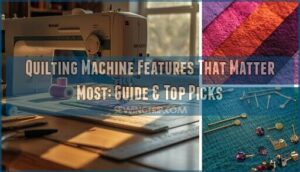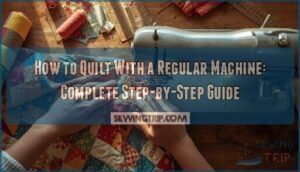This site is supported by our readers. We may earn a commission, at no cost to you, if you purchase through links.
Your closet doesn’t speak for you anymore. Those mass-produced clothes hanging there—the ones that fit sort of okay and look kind of like what you wanted—they’re not cutting it. Learning to sew your own clothes flips the script entirely.
You decide the fit, the fabric, the details that matter. Sure, you’ll need some basic tools like fabric scissors, a measuring tape, and a sewing machine that won’t fight you at every seam. But once you’ve got those essentials lined up and understand how patterns actually work, you’re free to create exactly what you want to wear—not what some factory decided to churn out this season.
Table Of Contents
Key Takeaways
- Sewing your own clothes gives you complete control over fit, fabric, and style details instead of settling for mass-produced garments that almost work.
- You need basic essentials like fabric scissors, a measuring tape, a reliable sewing machine, and quality notions before starting any project—don’t skip the prep work.
- Reading patterns correctly, choosing beginner-friendly fabrics like cotton, and transferring markings accurately prevents construction headaches later.
- Pressing every seam and checking fit throughout construction separates homemade-looking clothes from professional-quality garments you’ll actually wear.
Essential Tools and Supplies for Sewing Clothes
Before you cut a single piece of fabric, you need the right gear in your corner. I’m not talking about buying out the whole craft store—just a solid starter kit that’ll set you up for success.
A good pair of fabric shears and a reliable sewing machine will handle most beginner projects without breaking the bank.
Let’s break down what you actually need to get your sewing journey off the ground.
If you’re still narrowing down your options, check out this guide to the best sewing machines for beginners to see which features matter most.
Must-Have Sewing Tools for Beginners
You’ll need sharp fabric scissors (keep them for fabric only—seriously), a measuring tape for accuracy, pins to hold everything in place, and a basic sewing kit with hand sewing needles in different sizes.
A good seam ripper is another must-have from any basic sewing supplies list, since even experienced sewers need to fix mistakes occasionally.
Don’t forget thread types that match your fabric, a seam ripper for those inevitable oops moments, and quality fabric cutters.
Choosing the right material for your project—like understanding fabric choice for accessories—ensures durability and a professional finish every time.
These measuring tools and notions are your foundation before you even think about a sewing machine.
Choosing The Right Sewing Machine
Once you’ve got your basic tools, picking the right sewing machine feels like choosing your weapon of rebellion. Here’s what matters:
- Machine types – mechanical models offer reliability while computerized versions give you automatic features
- Stitch quality – test before buying
- Thread tension – adjustable controls prevent headaches
- Sewing speed – slower is better when learning
Don’t stress about perfect sewing machine operation yet. Focus on maintenance tips like regular cleaning and oiling to keep your machine humming.
Basic Notions and Materials Needed
Your machine won’t run without the right fuel. Thread in various weights, needles matched to your fabric selection, and a flexible measuring tape keep projects moving. Add sharp scissors, pins, and interfacing materials for structure. Here’s what transforms fabric into freedom:
| Notion | Purpose | Why You Need It |
|---|---|---|
| Thread Types | Seam construction | Holds everything together |
| Interfacing Materials | Structure and stability | Prevents floppy collars |
| Measuring Tape | Accurate sizing | No guesswork measurements |
| Fabric Scissors | Clean cuts | Fraying is your enemy |
| Sewing Notions | Professional finish | Details matter |
Stock these sewing notions now—you’ll thank yourself later.
Setting Up a Sewing Space
You can’t create magic in a cluttered corner with bad lighting—your sewing space sets the tone for every project you’ll tackle. Set up your sewing station near a window or bright lamp—lighting essentials matter more than you’d think. Keep your sewing machine at elbow height for an ergonomic setup.
Storage solutions like bins organize your sewing tools, measuring tape, iron, and sewing kit. Smart workspace organization means less hunting, more creating.
Before you start organizing, brush up on essential sewing terminology so you can label bins and find supplies faster.
Selecting Patterns and Fabrics
Picking the right pattern and fabric is where your sewing project either takes off or crashes before you even thread the needle. You need to understand how patterns work, what fabrics won’t make you want to throw your machine out the window, and how to prep everything so you’re not fighting with your materials later.
Let’s break down exactly what you need to know before you buy a single yard.
Understanding Sewing Patterns and Sizes
Sewing patterns are your blueprint for garment construction—they show you exactly where to cut and stitch. Pattern selection starts with size calculations using your bust, waist, and hip measurements. Don’t stress if you’re between sizes; pattern alterations are totally normal.
Look for beginner-friendly options with clear markings for grainline management and notion choices. Pattern making gets easier with practice, I promise.
Best Fabrics for Beginners
Natural fibers like cotton make fabric selection easier when you’re learning to sew—they’re forgiving and affordable. Cotton blends resist wrinkles better than pure cotton, which matters for woven fabrics. Knit fabrics work beautifully for beginners since they’re stretchy and hide small mistakes. Skip slippery silks for now.
Sustainable textiles like linen breathe well but need careful handling. Start simple, build confidence, then experiment.
How to Read and Choose Patterns
Pattern envelopes hold all the secrets you need—sizing charts, fabric requirements, and skill-level ratings—so learning to decode them saves you headaches before you even cut into your material. Match your measurements to the pattern sizing (ignore your store size—sewing patterns run different).
Start with “beginner” or “easy” labels. Look for simple silhouettes with fewer pieces.
Pattern selection gets easier once you understand garment fitting basics and your body’s unique shape.
Tips for Buying and Preparing Fabric
You can nail every step of your pattern perfectly, but if you skimp on fabric quality or skip the prep work, your finished garment won’t hang right—trust me, I’ve learned this the expensive way. To achieve the best results, consider optimizing your fabric purchase strategy to minimize waste and save money.
Before you buy, feel the fabric—woven fabrics should have body without stiffness. Check the weave types and fiber blends on the bolt end.
Smart fabric selection and preparation means:
- Prewash everything to avoid shrinkage disasters (learned that one twice)
- Press out wrinkles before cutting—textile science says heat sets fibers straight
- Check dye methods by rubbing white fabric against it—bleeding colors ruin seams
- Let fabric rest flat overnight after unwrapping so the weave relaxes back to its natural state
Your fabric choice shapes everything that follows, so don’t rush this step.
Preparing to Sew Your First Garment
You’ve picked your pattern and fabric—now it’s time to get everything ready before you actually start sewing. This prep work might feel a little tedious, but trust me, it’s what separates a hot mess from a garment you’ll actually want to wear.
Let’s break down the key steps you need to tackle before your needle hits the fabric.
Cutting Out Patterns and Fabric
Sharp scissors and precision make all the difference here. Lay your fabric flat, aligning pattern pieces with the fabric grain—that invisible backbone running parallel to the selvage. Pin down each pattern, respecting seam allowance boundaries. Use measuring tape to double-check spacing. Cut confidently along solid lines, not dotted ones.
Your cutting tools determine pattern accuracy, so invest in quality fabric scissors dedicated solely to cloth.
Transferring Markings and Notches
Once your pattern pieces are cut, those mysterious dots and lines hold the key to perfect alignment. Transferring markings and notches transforms confusing symbols into your sewing guide for seam accuracy.
- Use tailor’s chalk or disappearing fabric markers to trace darts and placement lines directly onto your fabric—tracing paper works wonders on heavier materials.
- Mark notches with tiny snips (1/8 inch max) into seam allowances, never cutting deeper.
- Transfer dots with fabric-safe pencils or pins to preserve pattern alignment without permanent damage.
- Double-check measuring tape distances between markings before removing patterns—this prevents construction chaos later.
- Choose marking tools based on fabric weight; delicate silks need gentler methods than sturdy denim.
These sewing techniques guarantee your pieces match perfectly during assembly, eliminating guesswork and frustration.
Applying Interfacing and Gathering Notions
With markings transferred, interfacing types become your fabric stability secret weapon. Fusible interfacing bonds with medium heat—test scraps first to avoid disaster. Cut it separately, leaving seam allowances clear to prevent bulk. Apply the smooth side down, pressing from the center outward.
For gathering techniques on sleeves or necklines, long basting stitches create controlled fullness. This sewing guide ensures your garment construction process starts strong, transforming floppy fabric into structured masterpieces using proper sewing interfacing and notion selection.
Organizing Steps for Construction
Once your fabric’s prepped and stabilized, the real magic happens when you map out your construction order like a battle plan—because sewing random seams whenever you feel like it’s a one-way ticket to frustration town. Your pattern preparation instructions reveal the garment assembly roadmap. Follow that sewing sequence religiously for clothing construction success:
- Read through all pattern instructions before starting
- Group similar tasks together for efficiency
- Mark each step as you complete it
- Keep pattern pieces organized by garment section
- Reference sewing guide and tutorials when confused
This garment construction process and fabric layout strategy prevents backtracking nightmares during garment making.
Step-by-Step Garment Construction
Alright, you’ve got your fabric cut and your pattern pieces ready—now comes the fun part where everything starts coming together. This is where you’ll actually build your garment from flat pieces into something you can wear.
I’m going to walk you through the essential construction steps that’ll take you from loose fabric to a finished piece hanging in your closet.
Sewing Seams, Darts, and Pleats
You’re about to master the building blocks of garment shaping—seams, darts, and pleats.
Start with seam construction, aligning notches and maintaining your seam allowance (usually 3/8 to 5/8 inch). Next, stitch darts to shape fabric around curves—press toward the center. Finally, tackle pleat folding with precise measurements.
These fabric manipulation techniques transform flat cloth into clothes that actually fit your body.
Attaching Pockets, Zippers, and Closures
Now you’ll attach the details that make your garment functional. Pin pockets first—patch pockets get topstitched around three edges, while set-in pockets need careful alignment.
Zipper installation takes patience; baste before final stitching. Add interfacing to closure areas for stability.
Finish seam edges with zigzag stitches to prevent fraying. These garment construction techniques separate homemade from handmade.
Assembling Sleeves, Collars, and Facings
You’re about to tackle the trickiest parts—sleeves, collars, and facings. These elements transform flat fabric into something you’d actually wear. Here’s your battle plan:
- Sleeve Cap Ease: Ease 1.5-2.5 cm into the armhole fit for natural movement—no puckering allowed
- Collar Construction: Apply interfacing tips first, then sandwich layers with right sides together
- Facing Techniques: Understitch facings so they stay hidden inside where they belong
- Pattern Drafting and Alteration: Match notches precisely using your sewing patterns for symmetry
These garment construction techniques require patience, but they’re your ticket to clothes that actually fit.
Pressing Techniques for a Professional Finish
Honestly, pressing might sound boring, but it’s the secret that separates homemade-looking clothes from garments that could pass for store-bought. Steam pressing opens up seams, smoothing fabric, and finishing into crisp folding excellence.
Pressing transforms homemade-looking clothes into store-bought quality—it’s the unglamorous secret that makes all the difference
Your iron becomes your best friend—press every seam flat before crossing it with another. This sewing technique transforms amateur work into professional results, and trust me, you’ll see the difference immediately.
Fitting, Finishing, and Wearing Your Clothes
You’ve sewn all the pieces together, and now comes the best part—making sure your garment actually fits and feels fantastic. This final stage is where your hard work transforms into something you’ll actually want to wear.
Let’s walk through how to check the fit, finish those last details, and keep your handmade clothes looking fresh.
Trying on and Adjusting Fit
Your first try-on is where the magic happens—or where you discover what needs tweaking. Slip on your garment and check your body measurements against the fit. Look at waist seams, ease adjustments, and overall drape.
This fit evaluation reveals if you nailed it or need garment alterations. Muslin testing beforehand helps, but nothing beats seeing your creation come alive on your body using this sewing guide.
Hemming and Final Stitching Methods
You’re almost at the finish line—now let’s lock in that hem. Blind hemming gives you nearly invisible results, while topstitching adds bold, decorative flair to your sewing clothes. Check your hem depth and sewing tension before you commit.
Edge finishing stops fraying cold. Mix hand sewing with machine techniques, and you’ll nail professional hems every time with these sewing tips and tricks.
Final Pressing and Quality Check
Your iron is the unsung hero of fabric finishing—don’t skip this step. Set the heat right for your material, use a pressing cloth on delicate pieces, and press every seam flat.
Then comes quality control: run your hands over each stitch, test all closures, and check measurements. This final garment testing separates homemade from handmade magic in clothing creation.
Tips for Styling and Caring for Handmade Clothes
You’ve stitched your masterpiece—now let’s make sure it stays runway-ready and lasts for years. Fabric care starts with washing handmade garments inside-out in cold water. Store them folded or on padded hangers to prevent stretching.
Mix your DIY clothing with thrift finds for sustainable fashion that screams “I made this!” Seasonal updates mean simple clothing alterations—swap buttons, adjust hems, or add accessories that breathe new life into your sew your own clothes journey.
Frequently Asked Questions (FAQs)
What type of fabrics are best for a beginner?
Cotton fabrics are your best friend when starting out. They’re forgiving, easy to handle, and won’t slip around like slippery synthetics.
Natural fibers like cotton and linen also press beautifully and hide beginner mistakes.
What type of sewing machine should I buy?
Choosing your first sewing machine is like picking a dance partner—you need someone reliable who won’t step on your toes. Mechanical machines offer simplicity, while computerized models provide automatic threading and varied stitch options for versatility.
What are the benefits of sewing my own clothes?
Sewing your own clothes unlocks sustainable fashion, personal style, and creative expression while saving money.
It’s DIY fashion that builds self-empowerment—you’re breaking free from cookie-cutter trends and claiming your unique look.
How can I find patterns that suit my individual style?
Breaking the mold starts with pattern selection that mirrors your personal aesthetics.
Hunt style inspiration on social media, then match sewing patterns to your body measurements and fabric choices—fashion design becomes truly yours.
What are the most important tips for a successful fit?
Measure yourself accurately with a measuring tape before choosing sewing patterns. Always check the pattern’s sewing ease and seam allowance.
Make fit adjustments early, and test the garment silhouette with inexpensive fabric before cutting your final material.
How do I fix common sewing mistakes?
Mistakes happen—that’s the truth of learning any craft. Fix uneven stitches with thread tension adjustments, use your seam ripper for error prevention and stitch correction, then press flat.
Fabric fray needs zigzag edges or binding for lasting seam repair.
Whats the best way to alter existing clothes?
Start by evaluating fit across bust, waist, and hip zones. Take in side seams 1–2 cm per side for most garments. Use tailor’s chalk, press between steps, and finish altered edges properly to prevent fraying.
How long does sewing a garment typically take?
Honestly? Your first t-shirt might eat up 2 to 4 hours, while a custom blouse demands 8 to Garment complexity, fabric choice, and your sewing skill level totally control construction speed—not magic.
Can I sew clothes without a sewing machine?
You absolutely can create garments using hand sewing needles and manual stitches—though it takes patience. Thread selection and fabric choice matter more when sewing by hand, making this sewing guide essential for beginners sewing clothes without machines.
Where can I find free sewing patterns online?
You’ll find tons of free sewing patterns on community-driven digital hubs, major pattern brand sites, and sewing blogs.
These online repositories offer downloadable PDF patterns for everything from clothing patterns to beginner apparel making projects.
Conclusion
A friend of mine spent years buying jeans that never fit right—too loose in the waist, too tight in the thighs. Then she learned to sew clothes herself. Now? Perfect fit, every time.
You’ve got the tools, the techniques, and the know-how. The only thing left is fabric and your vision. Stop settling for almost-right. Make something that’s completely, unapologetically yours. Your closet’s about to get a serious upgrade.
- https://sanvt.com/blogs/journal/fabric-weight-a-guide-to-gsm
- https://www.pinkhollybushdesigns.com/post/how-to-purchase-only-the-fabric-you-need-save-money
- https://www.seamwork.com/fabric-guides/how-to-sew-with-rayon-expert-tips-and-inspiring-projects
- https://applied-lab.com/understanding-crocking/
- https://www.myhandmadewardrobepatterns.com/techniques-and-inspiration-all/readytoparty-techniques-how-to-stay-stitch














